Related Research Articles
Voice over Internet Protocol (VoIP), also known as IP telephony, refers to a set of technologies used for voice communication sessions over Internet Protocol (IP) networks, such as the Internet. VoIP enables voice calls to be transmitted as data packets, facilitating various methods of voice communication, including traditional applications like Skype, Microsoft Teams, Google Voice, and VoIP phones. Regular telephones can also be used for VoIP by connecting them to the Internet via analog telephone adapters (ATAs), which convert traditional telephone signals into digital data packets that can be transmitted over IP networks.
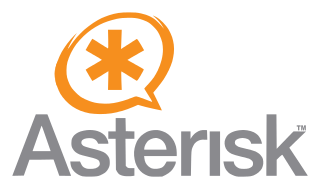
Asterisk is a software implementation of a private branch exchange (PBX). In conjunction with suitable telephony hardware interfaces and network applications, Asterisk is used to establish and control telephone calls between telecommunication endpoints such as customary telephone sets, destinations on the public switched telephone network (PSTN) and devices or services on voice over Internet Protocol (VoIP) networks. Its name comes from the asterisk (*) symbol for a signal used in dual-tone multi-frequency (DTMF) dialing.

A business telephone system is a telephone system typically used in business environments, encompassing the range of technology from the key telephone system (KTS) to the private branch exchange (PBX).

EchoLink is a computer-based amateur radio system distributed free of charge that allows radio amateurs to communicate with other amateur radio operators using Voice over IP (VoIP) technology on the Internet for at least part of the path between them. It was designed by Jonathan Taylor, a radio amateur with call sign K1RFD. Taylor has been the system engineer and administrator since 2002.
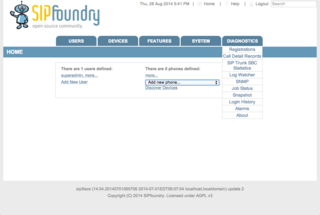
SipXecs is a free software enterprise communications system. It was initially developed by Pingtel Corporation in 2003 as a voice over IP telephony server located in Boston, MA. The server was later extended with additional collaboration capabilities as part of the SIPfoundry project. Since its extension, sipXecs now acts as a software implementation of the Session Initiation Protocol (SIP), making it a full IP-based communications system.
Radio over Internet Protocol, or RoIP, is similar to Voice over IP (VoIP), but augments two-way radio communications rather than telephone calls. From the system point of view, it is essentially VoIP with push-to-talk. To the user it can be implemented like any other radio network.

An amateur radio repeater is an electronic device that receives a weak or low-level amateur radio signal and retransmits it at a higher level or higher power, so that the signal can cover longer distances without degradation. Many repeaters are located on hilltops or on tall buildings as the higher location increases their coverage area, sometimes referred to as the radio horizon, or "footprint". Amateur radio repeaters are similar in concept to those used by public safety entities, businesses, government, military, and more. Amateur radio repeaters may even use commercially packaged repeater systems that have been adjusted to operate within amateur radio frequency bands, but more often amateur repeaters are assembled from receivers, transmitters, controllers, power supplies, antennas, and other components, from various sources.
Internet fax, e-fax, or online fax is the use of the internet and internet protocols to send a fax (facsimile), rather than using a standard telephone connection and a fax machine. A distinguishing feature of Internet fax, compared to other Internet communications such as email, is the ability to exchange fax messages with traditional telephone-based fax machines.
This is a comparison of voice over IP (VoIP) software that examines applications and systems used for conducting voice and multimedia communications across Internet Protocol (IP) networks. VoIP technology has transformed telecommunications by offering alternatives to traditional telephony systems while providing enhanced features and cost savings.
D-STAR is a digital voice and data protocol specification for amateur radio. The system was developed in the late 1990s by the Japan Amateur Radio League and uses minimum-shift keying in its packet-based standard. There are other digital modes that have been adapted for use by amateurs, but D-STAR was the first that was designed specifically for amateur radio.
Mobile VoIP or simply mVoIP is an extension of mobility to a voice over IP network. Two types of communication are generally supported: cordless telephones using DECT or PCS protocols for short range or campus communications where all base stations are linked into the same LAN, and wider area communications using 3G or 4G protocols.

FreePBX is a web-based open-source graphical user interface (GUI) that manages Asterisk, a voice over IP (VoIP) and telephony server.
Unified communications (UC) is a business and marketing concept describing the integration of enterprise communication services such as instant messaging (chat), presence information, voice, mobility features, audio, web & video conferencing, fixed-mobile convergence (FMC), desktop sharing, data sharing, call control and speech recognition with non-real-time communication services such as unified messaging. UC is not necessarily a single product, but a set of products that provides a consistent unified user interface and user experience across multiple devices and media types.

Elastix is a unified communications server software that brings together IP PBX, email, IM, faxing and collaboration functionality. It has a Web interface and includes capabilities such as a call center software with predictive dialing.
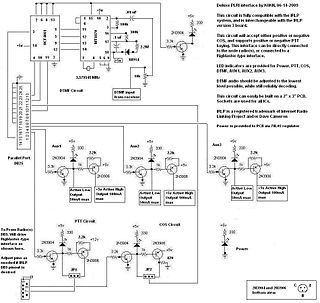
PLRI (Parallel Logic Radio Interface) is a set of circuits of interest to radio amateurs Amateur Radio (hams). These circuits are fully compatible with IRLP (Internet Radio Linking Project). IRLP is trademarked by Dave Cameron.
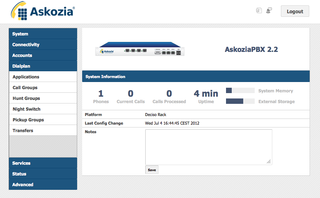
AskoziaPBX is a closed source telephone system firmware. It is a fork of the m0n0wall project and uses the Asterisk private branch exchange (PBX) software to realize all telephony functions.
SK7MQ also known as SK7RNQ B is a D-STAR Gateway enabled HAM repeater, located in Glumslöv, Landskrona Municipality, Sweden. It is set to transmit and receive on the 70 cm (28 in) UHF radio band.
It is currently held and maintained by its founder: Repeatergruppen SK7MQ, known as a part of "Österlens sändaramatörer".

The FreePBX Distro was a freeware unified communications software system that consisted of a graphical user interface (GUI) for configuring, controlling and managing Asterisk PBX software. The FreePBX Distro included packages that offer VoIP, PBX, Fax, IVR, voice-mail and email functions.
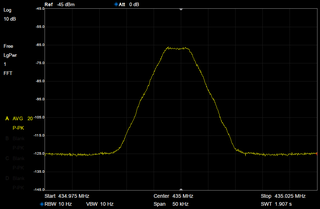
M17 is a digital radio modulation mode developed by Wojciech Kaczmarski et al. M17 is primarily designed for voice communications on the VHF amateur radio bands, and above. The project received a grant from the Amateur Radio Digital Communications in 2021 and 2022. The protocol has been integrated into several hardware and software projects. In 2021, Kaczmarski received the ARRL Technical Innovation Award for developing an open-source digital radio communication protocol, leading to further advancements in amateur radio.
References
- ↑ "Field deplorable (sic) linked repeater built on AllStar". myGMRS Forums. Retrieved 6 January 2025.
- ↑ "GMRS Linking Overview". New England GMRS. Retrieved 6 January 2025.
- ↑ "App_rpt users mailing list archive - December 2020" . Retrieved 6 January 2025.
- ↑ "App_rpt users mailing list archive - January 2021" . Retrieved 6 January 2025.
- ↑ "App_rpt users mailing list archive - February 2021" . Retrieved 6 January 2025.
- ↑ "App_rpt users mailing list archive - March 2021" . Retrieved 6 January 2025.
- ↑ "App_rpt users mailing list archive - April 2021" . Retrieved 6 January 2025.
- ↑ "Detail by Entity - Florida Not For Profit Corporation ALLSTARLINK, INC". Florida Division of Corporations. 6 January 2025. Retrieved 6 January 2025.
- ↑ "AllStarLink Terms of Use". AllStarLink. Archived from the original on 7 January 2025. Retrieved 6 January 2025.